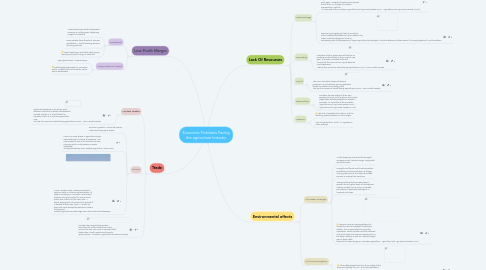
1. Low Profit Margin
1.1. Livestock
1.1.1. Lower beef prices will put downward pressure on cattle prices, tightening margins for feedlots
1.1.2. Dairy industry faces threats of Chinese importation + world lowering demand for dairy products
1.1.3. Lower beef prices will affect cattle prices, leaving small profit margin in feed lots.
1.2. Grain and Oil Seed
1.2.1. High global stock = lowered price
1.2.2. Profits highly dependant on Canadian Dollar. Market failure in this sector would end in devestation
2. Trade
2.1. United States
2.1.1. Continued weakness in oil prices and a different outlook for interest rates between Canada and the U.S. should lead the Canadian dollar to a new low against the USD. The top five economic trends facing agriculture in 2016 - Farm Credit Canada
2.2. China
2.2.1. Economic growth in China will slow as India’s economy gains speed.
2.2.2. China is a major player in agricultural trade, especially when it comes to soybeans. The new president said China devalues its own currency, which could position Canada awkwardly. Trump’s presidency and Canadian agriculture | Farms.com
2.2.3. Prime Minister Justin Trudeau was able to secure a delay in China’s implementation of tighter screening on Canadian canola seed exports during his visit to the G20 Summit earlier this month, but the new rules — which Beijing said is to prevent the spread of a disease to their own crops — remain an item that could disrupt the $2-billion trade in that product. Federal agriculture minister digs into China trade: five takeaways
2.3. Canada’s two largest trade partner countries, the United States and China, account for well over 70% of Canada’s total trade value in both exports and imports. Special Issues - Canadian Agricultural Economics Society
3. Environmental affects
3.1. Climate Change
3.1.1. As the frequency of events like droughts increases under climate change, crop yields would decrease.
3.1.2. Droughts and floods could reduce pasture availability and the production of forage, forcing producers to find alternative feed sources or reduce their herd size.
3.1.3. These would include increased weed growth due to higher levels of atmospheric Carbon Dioxide (CO2) and an increased prevalence of pests and pathogens in livestock and crops.
3.1.4. Warmer summers cause problems for livestock producers related to heat-wave deaths. This is especially true in poultry operations. Other impacts could be reduced milk production and reduced reproduction in the dairy industry, as well as, reduced weight gain in beef cattle. Impact of climate change on Canadian agriculture - Agriculture and Agri-Food Canada (AAFC)
3.2. Oil Consumption
3.2.1. If the whole planet were to eat according to the practices used by the USA, the entire petroleum reserves of the planet would be exhausted within 13 years. Dependence of agriculture on oil consumption | World Problems & Global Issues | The Encyclopedia of World Problems
4. Lack Of Resources
4.1. Technology
4.1.1. Canada's public R&D spending in the agriculture and agri-food sector, as a share of gross farm receipts (GFR), has decreased since 2007. However it continues to exceed that of the U.S., though it has been surpassed by Australia. An Overview of the Canadian Agriculture and Agri-Food System 2016 - Agriculture and Agri-Food Canada (AAFC)
4.1.2. Farmers are struggling to feed a record 86 million additional people each year, without any major new technologies to draw on. Decreasing rate of development of major agriculture technologies | World Problems & Global Issues | The Encyclopedia of World Problems
4.2. Funding
4.2.1. Purchases of farm equipment will decline as producers make efficiency their number one goal. The lower Canadian dollar will compound this issue as farm inputs become more expensive. The top five economic trends facing agriculture in 2016 - Farm Credit Canada
4.3. Land
4.3.1. The rise in farmland values will slow as producers re-evaluate the earning potential based on weaker commodity prices The top five economic trends facing agriculture in 2016 - Farm Credit Canada
4.4. Education
4.4.1. Canadian farmers relied on their own experience (91%) and the advice from peers (68%) when deciding whether to adopt or innovate. An Overview of the Canadian Agriculture and Agri-Food System 2016 - Agriculture and Agri-Food Canada (AAFC)
4.5. Labour
4.5.1. The lack of available farm labour and the resulting upward pressure on farm wages
4.5.2. Lack of interest from Youth -> Migration to urban settings

